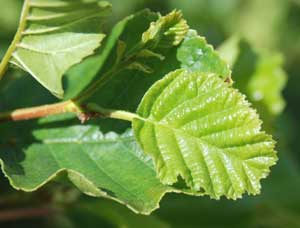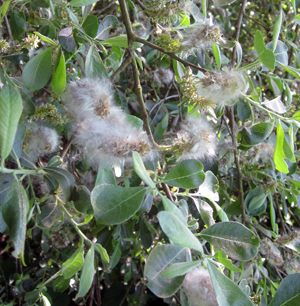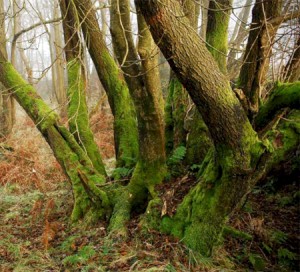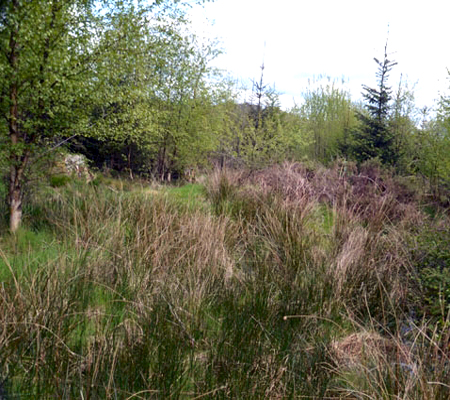Woodland types : Wet woodlands

After the last ice age, the melt water from glaciers and ice sheets created areas of open and wet habitat. It was a ‘fertile time’ for pioneer species such as willow, birch and alder. Nowadays, wet woodland is scattered throughout the U.K. and Ireland, though western areas with greater rainfall are more likely locations. Such woodland is associated with poorly drained or seasonally flooded areas, for example, the flood plains of rivers, or the edges of lakes, bogs and fens. Estimates of the area covered by wet woodland vary – but the Forestry Commission gives a conservative figure of 25 to 35,000 hectares. Much of it is relatively inaccessible and of little economic value. In consequence, it is often subject to drainage and/or clearance.
 Alder and willow are most frequently associated with present day wetland, though downy birch can be found in some areas (e.g. Morden Bay in Dorset). There are various species of willow – white willow (S.alba), crack willow (S.fragilis), goat willow (s. caprea), grey sallow (S. cinerea) and bay willow (S. pentandra). Willows interbreed and there are many hybrid forms. Willow can be cropped for basket weaving. Willow and alder can be found along rivers and streams, where they help to stabilise banks. Alder belongs to the same family as Birch (Betulaceae). It rarely grows to more than 20 metres or lives longer than 150 years. It grows quickly and is “short-lived” – typical of pioneer species. It fixes nitrogen (converts atmospheric nitrogen into organic form) and generally improves the soil. In the past, alder woods were coppiced, with the wood valued for its resistance to decay. In the past, alder was used in clog making and as a source of charcoal for gunpowder.
Alder and willow are most frequently associated with present day wetland, though downy birch can be found in some areas (e.g. Morden Bay in Dorset). There are various species of willow – white willow (S.alba), crack willow (S.fragilis), goat willow (s. caprea), grey sallow (S. cinerea) and bay willow (S. pentandra). Willows interbreed and there are many hybrid forms. Willow can be cropped for basket weaving. Willow and alder can be found along rivers and streams, where they help to stabilise banks. Alder belongs to the same family as Birch (Betulaceae). It rarely grows to more than 20 metres or lives longer than 150 years. It grows quickly and is “short-lived” – typical of pioneer species. It fixes nitrogen (converts atmospheric nitrogen into organic form) and generally improves the soil. In the past, alder woods were coppiced, with the wood valued for its resistance to decay. In the past, alder was used in clog making and as a source of charcoal for gunpowder.
 Wet woodland may be transient and short lived, due to the nature of the flooding; or due to the accumulation of soil / organic material. As the area begins to dry out, so succession towards ‘typical’ terrestrial woodland occurs. Wet woodland or carr can be rich in wild life. There may be a network of fallen trees, with a dense undergrowth of shrubs, sedges, reeds and herbs - as may be seen in some areas around the Norfolk Broads and the River Bure. Alder cones and birch seed are a food source for birds such as Siskin and Lesser Redpoll. Woodpeckers and Marsh Tits may also be found – and willows support a number of moth species. The dead wood found in such woodland supports many invertebrate species, particularly saproxylic beetles (Coleoptera). The biodiversity and unique nature of wet woodland is now recognised and incorporated into biodiversity action plans.
Wet woodland may be transient and short lived, due to the nature of the flooding; or due to the accumulation of soil / organic material. As the area begins to dry out, so succession towards ‘typical’ terrestrial woodland occurs. Wet woodland or carr can be rich in wild life. There may be a network of fallen trees, with a dense undergrowth of shrubs, sedges, reeds and herbs - as may be seen in some areas around the Norfolk Broads and the River Bure. Alder cones and birch seed are a food source for birds such as Siskin and Lesser Redpoll. Woodpeckers and Marsh Tits may also be found – and willows support a number of moth species. The dead wood found in such woodland supports many invertebrate species, particularly saproxylic beetles (Coleoptera). The biodiversity and unique nature of wet woodland is now recognised and incorporated into biodiversity action plans.
Comments are closed for this post.
Discussion
This encourages me to feel even more positive about my 3 and a half acres of bog, birch and willow – thanks!
Thanks Chris for this article


[…] that need to feed on Buckthorn and Alder Buckthorn. These are shrubs that both occur in wet woodland, but buckthorn also occurs also on dry chalk and limestone soils. Native pine woodland, not […]
Woodland moths and butterflies. | Woodlands.co.uk
9 September, 2016